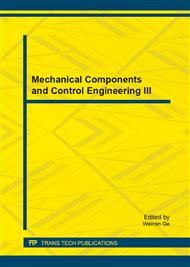[1]
Gong Liangliang, etc.: Research on process knowledge representation and decision-making process based on model definition. Machinery. Vol. 51(2013) , p.: 78-81.
Google Scholar
[2]
Tian Fujun, etc.: Modeling and application of process information based on model definition [J]. Computer Integrated Manufacturing Systems. Vol. 18(2012) , pp.913-919.
Google Scholar
[3]
Huang Lijiang, etc.: Exploring Rule-Fused Technology for Typical Process Representation and Automatic Process Decision. Journal of Northwestern Polytechnical University. Vol. 27(2009) , pp.583-588.
Google Scholar
[4]
Liu Yanbin, Zhao Haibing: Research on the technology and application based on 3D-CAPP . Machinery . Vol. 44(2006) , pp.14-16.
Google Scholar
[5]
Huang Jinghua, etc.: Research on the problem of uncertainty in process decision making for CAPP. Machinery. Vol. 42(2004) , pp.35-38.
Google Scholar
[6]
Su Yanyan: Process Planning-oriented Part information modeling based on STEP/AP224. Computer Aided Engineering. Vol. 13(2004) , pp.64-67.
Google Scholar
[7]
Ghang Lee, Charles M. Eastman: Rafael Sacks Eliciting information for product modeling using process modeling. Data & Knowledge Engineering. Vol. 62(2007) , p.292–307.
DOI: 10.1016/j.datak.2006.08.005
Google Scholar
[8]
Hu Wenwei, etc.: Parts information model and its application in integration of CAD/CAPP based on feature. Manufacturing automation. Vol. 27(2007), pp.439-442.
Google Scholar
[9]
Wang Dakang, etc.: Characteristic Information Modeling of Gyratory Parts. Journal of Beijing Polytechnic University. Vol. 29(2003), pp.391-395.
Google Scholar
[10]
Ren Shaochuan, etc.: The Research of CAPP System for Shaft Parts Based on Parameters and Characteristics . Modular Machine Tool & Automatic Manufacturing Technique. Issue. 4(2013), pp.139-141.
Google Scholar
[11]
Liu Wenwu, etc.: knowledge representation and knowledge base analysis for part features based on OWL. Journal of Guilin University of Electronic Technology. Vol. 33(2013), pp.305-308.
Google Scholar
[12]
Yanru Zhong, Yuchu Qin, Meifa Huang et al.: Automatically generating assembly tolerance types with anontology-based approach. Computer-Aided Design. Vol. 45(2013), pp.1253-1275.
DOI: 10.1016/j.cad.2013.06.006
Google Scholar
[13]
T. R Gruber: A Translation Approach to Portbale Ontology Specifications. Knowledge Acquisition. Vol. 5(1993) , pp.199-220.
DOI: 10.1006/knac.1993.1008
Google Scholar
[14]
B. Chnadrasekaran, J.R. Josephson, V.R. Benjmains: What are Ontologies and Why Do We Need Them. IEEE Intelligent Systems. Vol. 14(1999), pp.20-26.
DOI: 10.1109/5254.747902
Google Scholar


